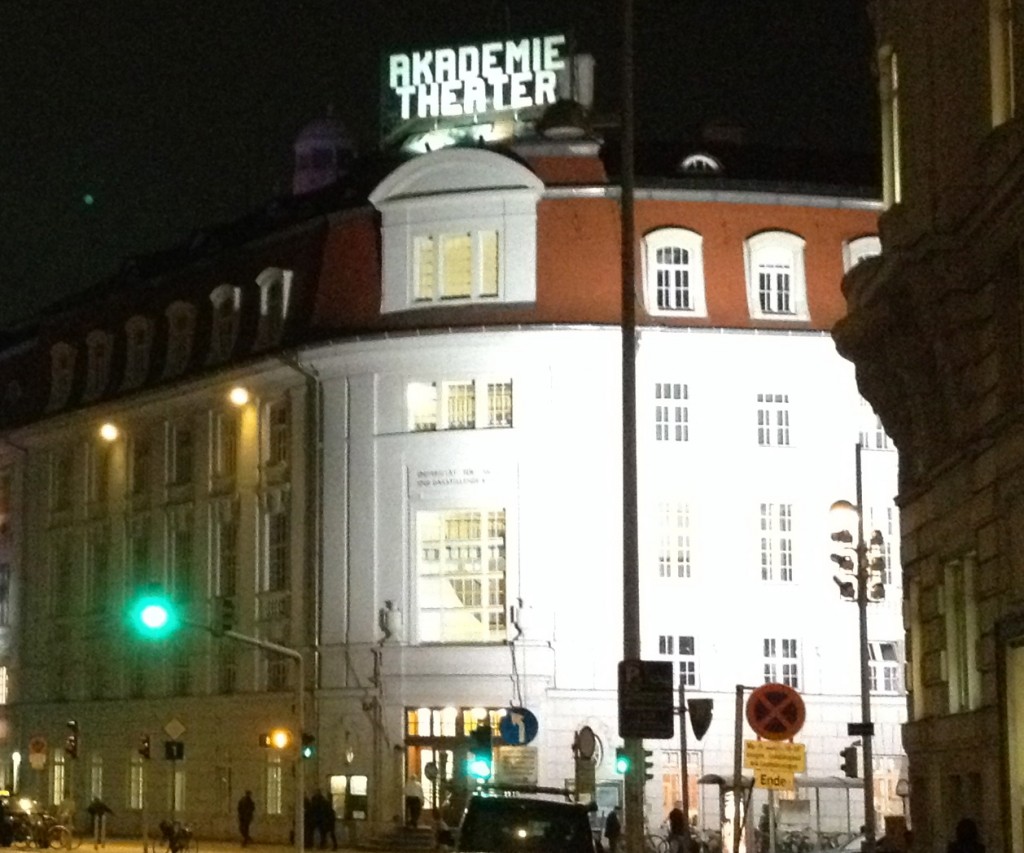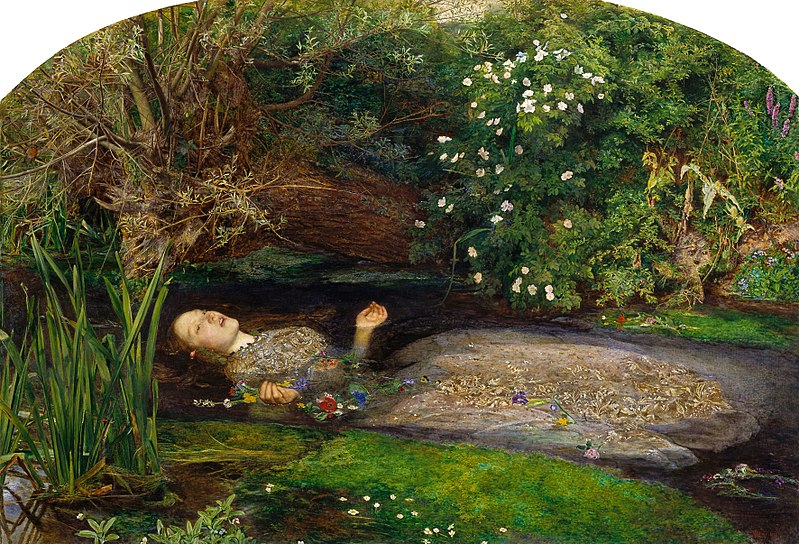Vienna, Day 1: The Lady from the Sea (Ibsen / Anna Bergmann), Akademietheater
A quickie, as my jet-lagged brain and Austrian-food-stuffed body aren’t up to more than that.
The Lady from the Sea is one of Ibsen’s infrequently performed plays, so if you need a plot summary (I would have), be thankful that Ibsen has a website. Bergmann’s production at the Akademietheater, the Burgtheater’s smaller second venue, makes a couple of significant changes to the script — for one thing, the mysterious lover from Ellida Wangel’s past, a real figure in Ibsen’s text, has become a figment of her imagination, a fantasy figure rather than an actual character; for another, whereas Ibsen casts the play as an alternative scenario to A Doll’s House, with a wife trapped in a marriage to which she returns when her husband lets her go, the kindness of the husband in Bergmann’s version comes in the form of assisted suicide: he helps Ellida drown herself.
Those two changes have very different consequences, though: the superficially unhappy ending, after all, can also be read as a kind of mutual sacrifice, a lethal gesture of generosity, and it’s played with a great deal of tenderness — even though the gurgling noises we hear from Ellida as the curtain descends may have been more ambiguous than that. Turning her past lover into a fantasy, though, reinvents Ellida as a delusional figure, rather than someone driven to despair and deep depression by the circumstances of her life. Not that there’s anything wrong with reconfiguring the character like that in and of itself. But it focusses the play on psychological processes or psychiatric concerns in a way that sits uneasily, to me, with the overall acting and staging styles of the production.
About the staging: visually and stylistically, this could have been a show a I saw this May in Berlin. We’ll see what the Burgtheater has in store for me over the next couple of days, but just based on this one production, a lot of the same theatrical elements that are en vogue in Berlin are equally current in Vienna. Naturalism is dead; music and live songs emphasize interpretative points or give access to a kind of quasi-authentic emotionality that the acting deliberately shuns; the entire stage space is visible for at least part of the time, and sets make no attempt at realism; there is a certain improvisational quality to the line delivery; and there’s water. (And I suppose I should mention what goes completely without saying here: of course the show isn’t in period dress.) On the other hand, no-one on stage acknowledged the audience as directly and freely as most of the productions I saw in May did (but then, neither did the Munich Kammerspiele’s Uncle Vanya, which I saw in July but didn’t have time to write about). Armin Petras’ Gorki Theater the Akademietheater is not.
There is much to love about all that. The water, in particular, is great — not just a theatrical fad, but a rendering literal of a metaphor Ibsen’s play is obsessed with. If water, and the sea in particular, is the site of freedom and a longed-for, lost ideal for Ellida in the text, in Bergmann’s production water itself has lost its freedom: we see it contained in a big aquarium that dominates the stage, and in an endless succession of vases with which Ellida’s step-daughter Bolette decorates the stage in honour of her father’s old friend (and her old teacher) Arnholm. Arnholm at one point climbs into the aquarium to “swim,” his doubled-over, crammed-in body illustrating that water in this form has no liberating quality at all. But that soon changes, when Ellida tears up a large section of the stage floor, revealing that the stylized 19th-century room that came down from the fly half an hour into the production in fact rests on a large water tank. That doesn’t turn water into a wholly positive force of liberation, of course: it’s also a corrosive presence, undermining the foundations of the house, and it’s a destructive element, ultimately the agent of Ellida’s death. But it’s the best she’s got. What struck me as especially lovely about this reveal was the way it combined a kind of raw realism with a total commitment to theatricality — Christiane von Poelnitz’s Ellida’s fury and despair may express themselves in a non-naturalistic fashion, by attacking and changing the set (and it’s clearly set elements she’s tossing around, not freshly ripped-up floor boards), but they read as fury and despair nonetheless. And the play of representation doesn’t end there, as character after character enters after the dramatic set change acknowledging the huge pool of water in their living room as if it were an interesting new feature, like an especially hideous lamp. The water may be symbolic, but it’s also real, and it’s treated that way over and over by actors and characters alike. (Quickly, another instance of this combination of the theatrical and the kind-of real: at various points, but most impressively in a cathartic scene between Wangel and Arnholm, the actors run through the same set of lines multiple times with completely different intentions and physical and vocal choices; the technique obviously shoves the scriptedness of the situation in the audience’s faces, but the intensity of the action does very conscious battle with that anti-realist move, and it works beautifully.)
It would be an easy shortcut to talk about the show’s symbolism, but I think it’s too post-something a production to really commit to anything as patly rigorous (or rigid) as a clear symbolic scheme. For instance, something is clearly going on with vases and flowers throughout the show: Bolette fills the vases by scooping water from the aquarium in the first scenes, and then she dumps all that water, and the plastic flowers along with it, into the living-room pond later on. Is that a gesture of liberation, though? Or symbolic of anything else? The gesture suggests significance, but it seems to me that Bergmann is too playful, too interested in theatricality for its own sake, and not quite systematic enough in her imagery to insist on what that significance might be. What the dumping of the flowers does, though, is create a number of tableaus, some of which at least are filmed from above and projected, sometimes to striking effect (and sometimes to no effect at all). That Ellida, visually, becomes John Everett Millais’ Ophelia the more time she spends lying among the flowers in her stagnant pool, is interesting (her long red hair added to the Pre-Raphaelite aesthetics) — but again, more as a visual effect than as an especially rich interpretative angle.
Lastly, the switch of focus to Ellida’s psyche comes at the price, to some extent, of loosening the parallels between her and her step-daughters (which may be a good thing). If she’s feeling trapped simply because she didn’t marry the man she loved and chose a life she didn’t want (as Ibsen has it), Bolette, who finally agrees to marry her former teacher, a man she repeatedly describes as a grossly inappropriate match, basically repeats her step-mother’s mistake — even if she does it to escape the place Ellida moved to as a result of her marrying Wangel. Hilde, the younger step daughter, may be similarly doomed in her marriage to the fatally ill, absurdly self-aggrandizing, and comically misogynistic would-be artist Lyngstrand. In Bergmann’s take, the three women are really very different characters: Ellida’s story is primarily one of psychological breakdown(s); even her sense of repression and her longing for the open sea and its promise of freedom may be pathological, if the freedom water offers is the freedom of death. Bolette is played by Alexandra Henkel as a figure trapped by the social circumstances of her life, cut off from higher education and a world in which she could play a role beyond the domestic, and her marriage to Arnholm seems to hold at least a fragment of hope still as the play ends. And Jasna Fritzi Bauer’s Hilde is a study in youthful cynicism, a character as playful as she is manipulative, and clearly not in any danger of being shackled by Christoph Luser’s Lyngstrand — whose grand claims for his own mission in life got the loudest laughs of the night, and who dies while attempting a pirouette in the closing moments of the show.
However, if all three women face quite different challenges and respond in quite different ways to them, the political point of the play gets diluted beyond recognition. I can see what Ibsen’s point was (though I may not like it). I’m not sure I quite know what Bergmann’s is. Which is to say, as much as I loved the show’s commitment to a vibrant theatricality, and as much as I admired its ability to retain the power to generate emotions even in the midst of all the playfulness, I don’t know that the whole show adds up to more than an assembly of really interesting, really enjoyable parts.
A flippant PS: I also couldn’t help but giggle whenever Arnholm yelped an impassioned “Bolette,” as the word sounds practically identical to one German word for Hamburger (Bulette). But it seems I was largely alone in this, so perhaps the name doesn’t have the same connotations for Austrian audiences. Or I’m just uncommonly immature.
- Click to email a link to a friend (Opens in new window)
- Click to print (Opens in new window)
- Click to share on Facebook (Opens in new window)
- Click to share on Twitter (Opens in new window)
- Click to share on Tumblr (Opens in new window)
- Click to share on LinkedIn (Opens in new window)
- Click to share on Reddit (Opens in new window)
- Click to share on Pinterest (Opens in new window)
Recent Comments
- Premodern Performance-based Research: A Partial Bibliography – Alabama Shakespeare Project on My Trouble with Practice-as-Research
- Premodern Performance-based Research: A Partial Bibliography – Alabama Shakespeare Project on Where is the Theatre in Original Practice?
- Alex on Steven Moffat, Sherlock, and Neo-Victorian Sexism
- Tim Keenan on Where is the Theatre in Original Practice?
- Holger Syme on 1920s Berlin Theatre: Research Marginalia 1
Archives
- November 2021
- April 2020
- March 2020
- October 2019
- January 2019
- December 2018
- November 2018
- October 2018
- March 2018
- February 2018
- January 2018
- July 2017
- May 2017
- March 2017
- November 2016
- October 2016
- September 2016
- August 2016
- June 2016
- May 2016
- January 2016
- December 2015
- November 2015
- October 2015
- September 2015
- August 2015
- July 2015
- June 2015
- May 2015
- February 2015
- January 2015
- November 2014
- October 2014
- September 2014
- August 2014
- July 2014
- May 2014
- April 2014
- March 2014
- February 2014
- January 2014
- November 2013
- October 2013
- September 2013
- August 2013
- July 2013
- May 2013
- April 2013
- March 2013
- January 2013
- December 2012
- November 2012
- October 2012
- September 2012
- August 2012
- July 2012
- April 2012
- March 2012
- February 2012
- January 2012
- December 2011
- November 2011
- October 2011
- September 2011
- August 2011
- July 2011
- June 2011
- May 2011
Copyright

Holger Syme's work is licensed under a Creative Commons Attribution-NonCommercial 3.0 Unported License.Images may be reused as long as their source is properly attributed in accordance with the Creative Commons License detailed above. Many of the photos here were taken at the Folger Shakespeare Library; please consult their policy on digital images as well.





